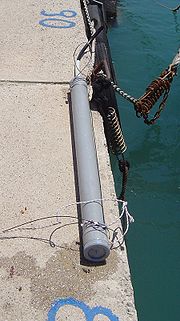
Tide gauge
Encyclopedia

Sensors continuously record the height of the water level with respect to a height reference surface close to the geoid
Geoid
The geoid is that equipotential surface which would coincide exactly with the mean ocean surface of the Earth, if the oceans were in equilibrium, at rest , and extended through the continents . According to C.F...
. Water enters the device by the bottom pipe (far end of the tube, see picture), and electronic sensors measure its height and record it to a tiny computer.
Data is available for over 1,750 stations worldwide. At some places records cover centuries, for example in Amsterdam
Amsterdam
Amsterdam is the largest city and the capital of the Netherlands. The current position of Amsterdam as capital city of the Kingdom of the Netherlands is governed by the constitution of August 24, 1815 and its successors. Amsterdam has a population of 783,364 within city limits, an urban population...
where data dating back to 1700 is available. When it comes to estimating the greater ocean picture, new modern tide gauges can often be improved upon by using satellite data.
Tide gauges are used to measure tides and quantify the size of tsunami
Tsunami
A tsunami is a series of water waves caused by the displacement of a large volume of a body of water, typically an ocean or a large lake...
s.
The measurements make it possible to derive the mean sea level
Sea level
Mean sea level is a measure of the average height of the ocean's surface ; used as a standard in reckoning land elevation...
. Using this method, sea level slopes up to several 0.1 m/1000 km and more have been detected.
A tsunami can be detected when the sea level begins to rise, although warnings from seismic activity can be more useful.
Tide Gauge at Fort Denison in Sydney, Australia
Tides have been measured at Fort Denison since 1857 on completion of the fort, initially using a bench mark cut into the stonework of the Martello Tower. From 1867 successive instruments were used as tide measuring technology developed.The Fort Denison photographs below show float activated tide gauge instruments in a cabinet and the system's stilling well. A wire connected to the upper drum mechanism and passes out through the bottom right of the cabinet and runs over a pulley to drop down to the float system in the large pipe in the well. This system is now obsolete at Fort Denison but maintained as a museum exhibit. To the right of the large pipe in the well is an enclosed pipe which rises to the active modern system.
Tide heights and times at Fort Denison are the primary referent for published tide information for other places in the state of New South Wales.

